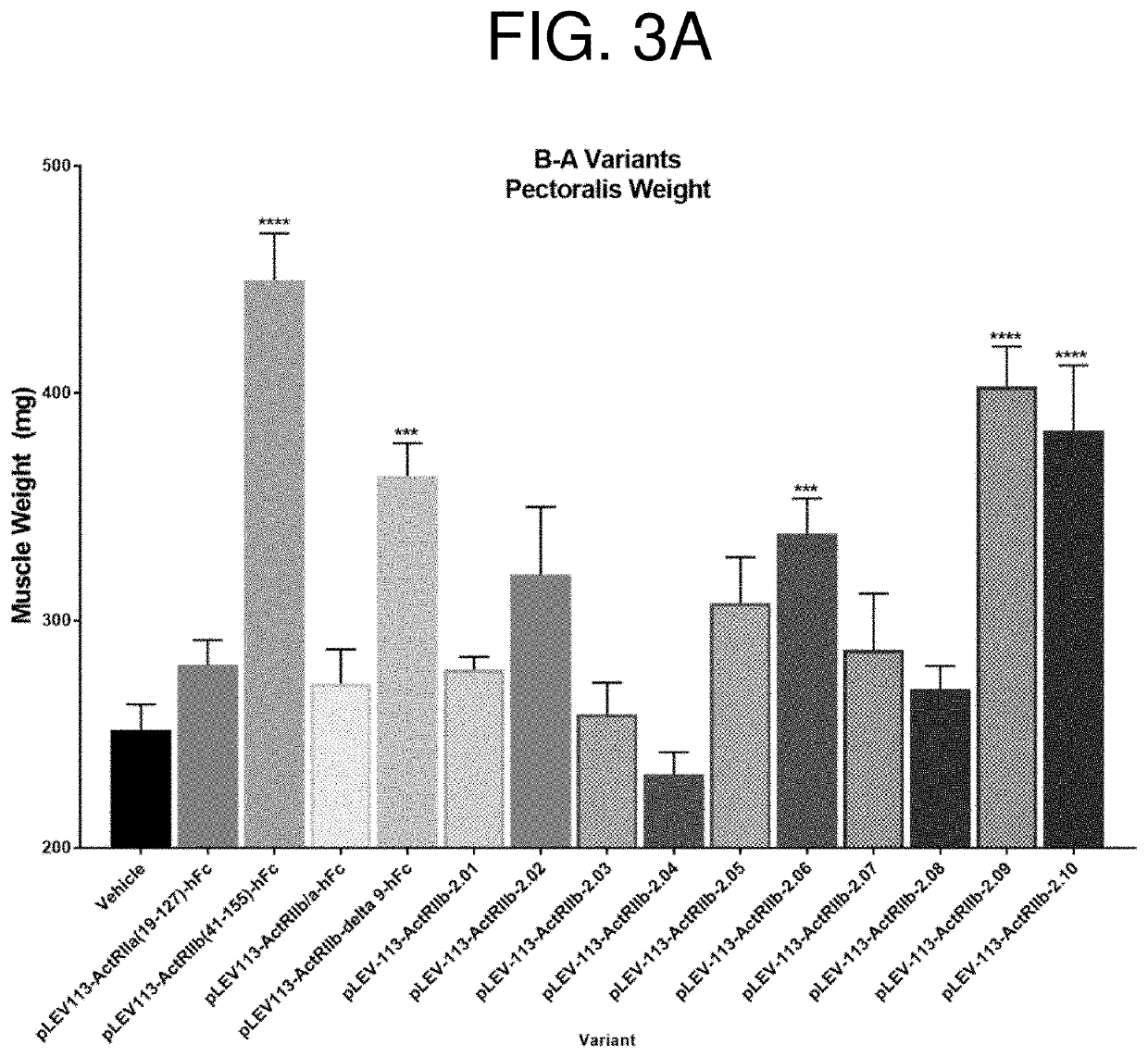Activin receptor type iib variants and methods of use thereof
a technology of activin receptor and variant, applied in the direction of transferases, peptide/protein ingredients, drug compositions, etc., can solve the problems of net bone loss, bone damage, and inability to improve the treatment and survival of subjects with these devastating muscle diseases, so as to increase muscle mass and strength, increase the stability of polypeptides, and increase the effect of muscle mass or bone mineral density
- Summary
- Abstract
- Description
- Claims
- Application Information
AI Technical Summary
Benefits of technology
Problems solved by technology
Method used
Image
Examples
example 1
Effect of Extracellular ActRIIB Variants on Body Weight and Muscle Weight
[0312]C57BI / 6 mice received a single hydrodynamic injection of a plasmid construct encoding one of the following fourteen polypeptides or vehicle control (n=10 / group, see sequences provided in FIG. 1):[0313](1) Vehicle,[0314](2) extracellular ActRIIA (SEQ ID NO: 16) fused to the N-terminus of hFc through a GGG linker;[0315](3) extracellular ActRIIB (SEQ ID NO: 17) fused to the N-terminus of hFc through a GGG linker;[0316](4) extracellular ActRIIB variant ActRIIB / A (SEQ ID NO: 2) fused to the N-terminus of hFc through a GGG linker;[0317](5) extracellular ActRIIB variant ActRIIBΔ9 (SEQ ID NO: 3) fused to the N-terminus of hFc through a GGG linker;[0318](6) extracellular ActRIIB variant ActRIIB 2.01 (SEQ ID NO: 4) fused to the N-terminus of hFc through a GGG linker;[0319](7) extracellular ActRIIB variant ActRIIB 2.02 (SEQ ID NO: 5) fused to the N-terminus of hFc through a GGG linker;[0320](8) extracellular ActRIIB...
example 2
Evaluation of ActRIIB Variants Binding Affinity by Surface Plasmon Resonance (SPR)
[0329]The GE Biacore 3000 was used to measure the kinetics of the interactions between the ActRIIB-Fc variants and the ligands Activin A, Activin B, growth differentiation factor 11 (GDF11), and BMP-9. ActRIIA, ActRIIB, ActRIIB 2.06, ActRIIB 2.11 and ActRIIB 2.12 were recombinant proteins. All other ActRIIB-Fc variants were expressed by transient expression in HEK293 cells and purified from the conditioned media using Protein-A Sepharose chromatography. Flow cells 1-4 were immobilized with anti-human / anti-mouse capture antibodies from GE using the amine coupling kit. The ActRII-Fc proteins were then captured on the chip in flow cells 2-4, with flow cell 1 being left empty as a reference cell to measure and subtract any nonspecific binding. HBS-EP+buffer from GE Healthcare™ was used as a running buffer. Each ligand was run in a duplicate concentration series at 40 μl / min to avoid mass transport effects....
example 3
Effect of Extracellular ActRIIB Variants on Bone Mineral Density
[0330]Adult male C57 / BL6 mice receive either a sham- (SHAM) or castration-surgery (ORX). Both surgery groups are allowed to recover for 14 days post-surgery. All animals are housed in conventional cages with free access to food (regular chow) and water. SHAM and ORX animals are then assigned to either a vehicle-treated group (VEH) or ActRII variant-treated group and receive bi-weekly systemic intraperitoneal administration of vehicle or ActRII variant (10 mg / kg) for 71 d. Body weights are measured twice per week at the time of treatment. Body composition is analyzed at study day 0 then at days 14, 28, 47, and 71 after treatment initiation using the MiniSpec LF50 NMR Analyzer. At study termination date, tissues of interest (muscles, fat depots, and tibias) are surgically removed, weighed, and properly stored for further analysis. At this time, the ORX animals are also examined to confirm complete removal of testes. Corti...
PUM
| Property | Measurement | Unit |
|---|---|---|
| Composition | aaaaa | aaaaa |
Abstract
Description
Claims
Application Information
 Login to View More
Login to View More - R&D
- Intellectual Property
- Life Sciences
- Materials
- Tech Scout
- Unparalleled Data Quality
- Higher Quality Content
- 60% Fewer Hallucinations
Browse by: Latest US Patents, China's latest patents, Technical Efficacy Thesaurus, Application Domain, Technology Topic, Popular Technical Reports.
© 2025 PatSnap. All rights reserved.Legal|Privacy policy|Modern Slavery Act Transparency Statement|Sitemap|About US| Contact US: help@patsnap.com



